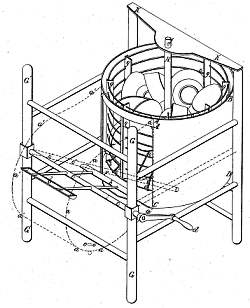 The nature of my invention consists in placing the crockery or other
articles of table furniture in a machine fitted to receive them, and
then to wash them, by turning a shaft with arms and buckets so arranged
as to throw the water upon the crockery with force, and thus acting
upon and cleansing each and every article.
The nature of my invention consists in placing the crockery or other
articles of table furniture in a machine fitted to receive them, and
then to wash them, by turning a shaft with arms and buckets so arranged
as to throw the water upon the crockery with force, and thus acting
upon and cleansing each and every article.